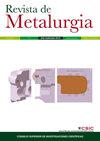Investigation of metallurgical properties of Al-Si-Mg casting alloys with integrated computational materials engineering for wheel production
IF 0.8
4区 材料科学
Q4 METALLURGY & METALLURGICAL ENGINEERING
引用次数: 0
Abstract
In this study, integrated computational materials engineering, which is one of the new generation approaches in materials science, was used in the production of aluminum alloy wheels by low pressure die casting method. In casting alloys, the efficiency of grain refinement provided by master alloys added to the melt decreases with increasing silicon content of the alloy. In this context, as-cast properties of silicon reduced (Si: 5.0 wt.%) alloys with different Mg ratios (Mg: 3.0, 5.0, 7.0 wt.%) are discussed using integrated computational materials engineering approaches. It has been evaluated whether the examined alloys can be an alternative to the AlSi7Mg0.3 alloy, which is currently used traditionally in the production of aluminum-based wheels, with their microstructural and mechanical properties. The study consists of three stages which are computer-aided production, pilot production, testing and characterization studies. In computer-aided production, original sub-eutectic compositions were determined in types and amounts of alloying elements, alloy designs were realized and a database was created with a computational materials engineering software. Then, low pressure die casting analysis were performed in a virtual environment by transferring these data directly to the casting simulation software. Thus, the microstructural and mechanical properties of the wheel were obtained computationally on the basis of the varying alloy composition. In the second stage, the virtually designed alloy compositions were prepared and sample wheels were manufactured by the low pressure die casting method on an industrial scale. In the testing and characterization phase, spectral analyses, macro and microstructural examinations, hardness measurements and tensile tests were carried out. As a result of this study, it was determined that the studied alloys could be used in the production of wheels by the low pressure die casting method considering the metallurgical properties expected from the wheel. In addition, it is thought that the mathematical design of the material with integrated computational materials engineering approaches before casting simulations will play an active role in the competitiveness and sustainability of the aluminum industry in technological conditions.车轮生产用集成计算材料工程研究Al-Si-Mg铸造合金的冶金性能
本研究将集成计算材料工程作为材料科学的新一代方法之一,应用于低压压铸法生产铝合金车轮。在铸造合金中,添加到熔体中的中间合金提供的晶粒细化效率随着合金中硅含量的增加而降低。在此背景下,使用集成计算材料工程方法讨论了具有不同Mg比(Mg:3.0、5.0、7.0 wt.%)的硅还原(Si:5.0 wt.%的)合金的铸态性能。已经评估了所检查的合金是否可以替代AlSi7Mg0.3合金,该合金目前传统上用于生产铝基车轮,具有其微观结构和机械性能。该研究包括三个阶段,即计算机辅助生产、中试生产、测试和表征研究。在计算机辅助生产中,确定了合金元素的类型和数量的原始亚共晶成分,实现了合金设计,并使用计算材料工程软件创建了数据库。然后,通过将这些数据直接传输到铸造模拟软件,在虚拟环境中进行低压压铸分析。因此,在合金成分变化的基础上,通过计算获得了车轮的微观结构和力学性能。在第二阶段,制备了虚拟设计的合金成分,并通过工业规模的低压压铸方法制造了样品车轮。在测试和表征阶段,进行了光谱分析、宏观和微观结构检查、硬度测量和拉伸测试。本研究的结果表明,考虑到车轮的冶金性能,所研究的合金可用于低压压铸法生产车轮。此外,人们认为,在铸造模拟之前,采用综合计算材料工程方法对材料进行数学设计,将对铝行业在技术条件下的竞争力和可持续性发挥积极作用。
本文章由计算机程序翻译,如有差异,请以英文原文为准。
求助全文
约1分钟内获得全文
求助全文
来源期刊

Revista De Metalurgia
工程技术-冶金工程
CiteScore
1.30
自引率
25.00%
发文量
18
审稿时长
>12 weeks
期刊介绍:
Revista de Metalurgia is a bimonhly publication. Since 1998 Revista de Metalurgia and Revista Soldadura have been combined in a single publicación that conserves the name Revista de Metalurgia but also includes welding and cutting topics. Revista de Metalurgia is cited since 1997 in the ISI"s Journal of Citation Reports (JCR) Science Edition, and in SCOPUS.
 求助内容:
求助内容: 应助结果提醒方式:
应助结果提醒方式:


